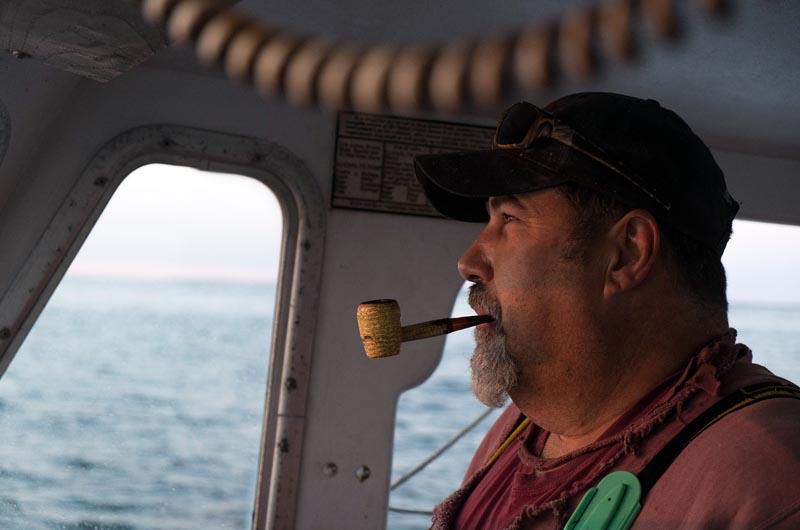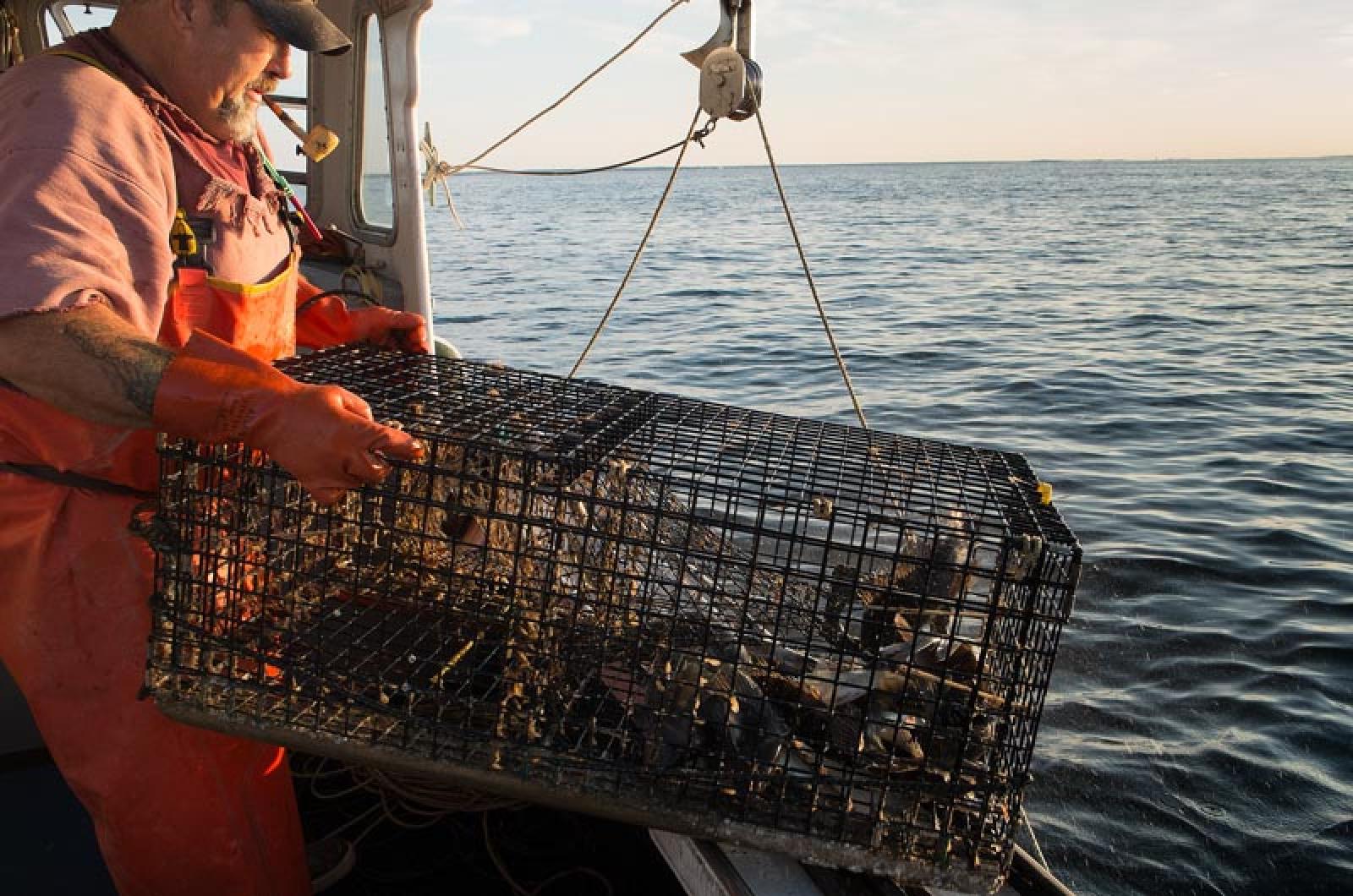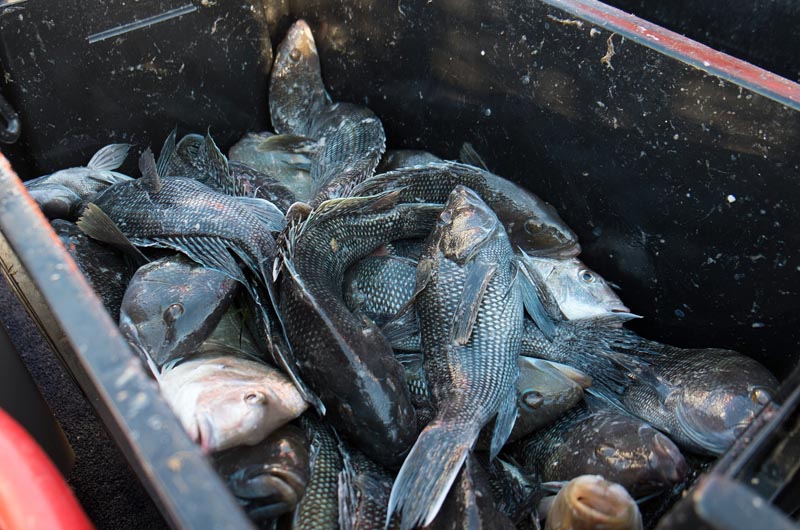On Tuesday morning, just a few minutes after 5 a.m., Lake Tashmoo is still and flat. There is a chill of autumn in the air, and in the water reflections of the stars glisten. In the distance a thin band of crepuscular light marks the eastern horizon.
Capt. David (Tubby) Medeiros, 50, and his son Cory, 14, are part of this early morning scene as they head on the water in their boat, Billie H., to haul pots of black sea bass.
The father and son are quiet, and for now, as they prepare for the day, the work is light. They travel out across Vineyard Sound into Nantucket Sound to the fishing grounds.
“With conch fishing, it is a 12-hour day,” Tubby says. With black sea bass, the two will be home before lunch.
As a commercial fisherman, Tubby has become a rarity on the Vineyard waters, still able to make a year-round living on the water. He does this by working different fisheries. He hauls pots loaded with conch from April to December. “When the first snowflake hits the water, it is over for conching,” Tubby says.
Then he shifts to bay scalloping. And in late summer he fishes for black sea bass until the quota is taken, usually before fall.
Black sea bass is an important fishery, yet it is also one of the Vineyard’s least appreciated fish. The epicenter of the coastal black sea bass fishery is Nantucket and Vineyard Sound, according to state fisheries records. The bulk of what Tubby lands gets shipped off-Island to the New York city market.
Last year there were 58 black sea bass fishermen in Massachusetts, of which 10 of them actively pursued the fish from Martha’s Vineyard, according to state records. Those Island pot fishermen landed 18,712 pounds last year, which represented 13.6 per cent of the state quota of 137,700 pounds. The Massachusetts quota last year was 282,100 pounds. For purposes of comparison, last year Massachusetts striped bass commercial fishermen had a quota almost four times that size.
While rod and reel recreational fishermen enjoy catching the bounty all summer, the commercial fishing season began on August 5 and the season is expected to last only a couple of weeks, when the 282,000-pound quota is taken.
Captain Medeiros fishes for black sea bass with baitless pots. He is allowed to catch 300 pounds of fish a day, and he does it easily when the weather is fair. He fishes 80 pots, although he is allowed to have a lot more. Each pot weighs 32 pounds, and although much of the hauling is done with a hydraulic winch, it is strenuous work.
A black sea bass pot looks like a lobster pot on the inside and out. The pot is divided into two rooms, the parlor and the kitchen. The significant difference between a lobster pot and a black sea bass pot is that there is no bait. The fish simply wander in and then can’t get out.
“They are a curious fish,” Tubby says, explaining why they swim into the pot. The trap also catches large scup. Cory is charged with moving the pots after they’ve been hauled up, emptying them, sorting the fish and releasing the small fish.
“He knows what to do,” the captain says of his son. “We’ve been fishing together for a long time. I have pictures of him in the boat when he was four years old.”

Cory looks at his father and smiles.
Below deck the Caterpillar diesel engine roars while on top there is music from an oldies radio station, and on the marine radio the banter of other fishermen out on the Sound is heard.
Tubby checks the screen of his fish finder, an electronic sonar device that sits just to the left of his steering wheel. It plots the character of the bottom and the fish underneath in real time. The bottom of Nantucket Sound, where he fishes, is sandy. The movement of the currents over time established large ridges along the bottom, similar to the ridges on a bay scallop shell. The fish hang out between those ridges.
Tubby fishes in a large area half-way between Edgartown and Centerville. To the east he can see the Cape Wind meteorological tower near Horseshoe Shoal. To the west, he sees the Steamship Authority ferries running back and forth across the water between Oak Bluffs and Nobska Point.
By 10 a.m., the two fishermen have filled a large tub with all the fish they need to call it a day. The boat heads west. The morning is warm and the water glistens off the stern.
By late morning, the fish are delivered to a Vineyard Haven fish handler who ships all of it to New York city.
“You can’t beat this for a summer job,” Tubby says at the end of the trip. “Who can get better quality time, when you are out on the ocean with your kid?”










Comments (4)
Comments
Comment policy »